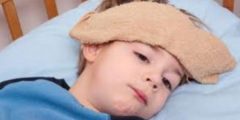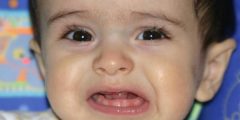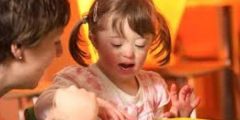Tips and instructions to relieve nasal congestion in children
Before detailing the treatment of nasal congestion, it is noteworthy that nasal congestion (in English: nasal congestion) or nasal congestion (in English: stuffy nose) occurs when the tissues lining the nose swell as a result of inflammation of the blood vessels located there, and this congestion may be accompanied by a runny nose, and it may A runny nose leads to a cough or sore throat if mucus flows to the back of the throat. This condition is known as postnasal drip, and it is worth noting that nasal congestion may be more of a source of concern to parents than a cough or sore throat. Because of its effect on the child’s ability to breathe, there are some home options that can relieve nasal congestion, including the following:
Steam inhalation
Inhaling steam in the bathroom is the safest way to inhale steam for children. Steam can help thin the thick mucus, making it easier for the child to breathe, so it is recommended to give the child a warm bath before bed.
Air humidification
Using humidifiers, especially cold mist humidifiers, helps maintain air humidity, and this in turn helps relieve dry cough and reduces nasal congestion, especially during the night. Therefore, it is recommended to place an air humidifier in the child’s room, taking care not to Leaving the child alone near the device, in addition to the need to keep the device clean, because mold may grow easily in damp places.
Read also:Why does the child put his hand in his mouth?
Nasal aspirator and saline nose drops
The nasal aspirator is in the form of a rubber ball with a removable plastic tip. The sharpness of the plastic tip helps parents ensure that the aspirator is not inserted deeply into the child’s nose, which may lead to damage to the mucous membrane. In addition, the plastic tip is able to Completely blocking the nostril, which increases the effectiveness of using the nasal aspirator. It is worth noting that pre-wetting the nose may make removing secretions with the nasal aspirator more effective and easier. A rubber ball syringe can be used to clean the child’s nose, and saline nasal drops can be used with this syringe to achieve More effective, these salt solutions are available in pharmacies without the need for a prescription to obtain them, or they can be prepared at home by adding half a teaspoon of salt with approximately 250 ml of warm water.
Below we explain how to use saline solution to clean the child’s nose:
- Gently place the child on his back and place a towel under him; To help keep his head tilted back.
- Put two to three drops of saline solution in each nostril, as this in turn helps thin the mucus that causes congestion.
- Try to maintain a stable position for the child for about a minute after applying the drops.
- Place the child in a sitting position, then press the circular part of the syringe to empty the air.
- Gently insert the rubber tip of the syringe into one of the child's nostrils, being careful not to insert it too deeply.
- Gently press your finger on the other nostril, which in turn increases the effectiveness of suctioning the mucus.
- Gradually relieve pressure on the rubber ball, during which mucus or fluids are pulled out of the nose.
- Remove the tip of the syringe from the nostril and press it to empty its contents onto a tissue.
- Wipe the syringe and repeat the previous steps to clean the other nostril.
- Make sure to clean the syringe properly after using it.
- Avoid using saline nose drops for more than a few days in a row; This may lead to dryness of the child's nose.
- Avoid using the nasal aspirator several times per day; So as not to irritate the sensitive lining in the child's nose.
Read also:Causes of yellowing of the face in children
Drink fluids
Drinking water and other fluids may help thin the mucus, making it easier for the child to cough. In addition, fluids help prevent dehydration if the child has a fever. If the child is more than three months old, he is given milk. Formula or breast milk. As for older children, they can be offered other drinks, such as warm soup, as it is indicated that warm soup may reduce inflammation in the upper respiratory tract, which may alleviate the symptoms of congestion.
Get comfortable
Sick children are usually not active, especially if they have a fever. This is because the child's body is working hard to try to fight the disease; Therefore, it is recommended to encourage the child to rest as much as possible so that he can recover, as sleeping in such a situation is the ideal solution. The child can also be entertained with quiet play, or time can be spent with the child to keep him calm.
Change sleeping position
Nasal congestion usually worsens during the night, due to the difficulty in clearing the sinuses of mucus when lying down. Some children may feel thirsty at night if they suffer from congestion and sleep with their mouths open. To relieve nasal congestion when sleeping, it is preferable to raise the top of the child’s mattress. Slightly, by placing a folded towel or pillow under the top of the child's mattress.
Read also:The length of the child at birth
Maintaining clean surrounding air
Air pollution may significantly affect a child's health; The American Lung Association indicated that children who live in areas with clean air are exposed to respiratory problems such as phlegm, congestion, and coughing at a lower rate than other children, as exposure to smoke inside the home or inside the car may exacerbate congestion. Nose: The smoke resulting from tobacco causes inflammation of the nasal lining in addition to increasing the production of mucus, which in turn causes nasal obstruction, especially when the child is sick. Therefore, parents are advised not to smoke at all near their children in all cases, and in cases of nasal obstruction in particular. This helps relieve the child's nasal congestion faster.
Over-the-counter pain relievers
Over-the-counter pain relievers, such as acetaminophen (known as paracetamol), and ibuprofen, can be used to treat symptoms associated with nasal congestion, such as facial pain associated with congestion or fever, but these painkillers are not used to relieve or treat congestion, and it should be noted. It is necessary to consult a doctor before using these painkillers for newborns, and according to the American Academy of Pediatrics, in most cases the use of ibuprofen is safe for children over the age of 6 months, and the use of acetaminophen is safe for children of all ages. Parents must be careful to choose a medication that is safe for the child, and follow instructions that help them determine doses based on the child’s weight. It should be noted that it is necessary to consult a doctor if the child with nasal congestion is less than 3 months old and suffers from a fever.
Nasal strips for children
Nasal strips are a safe means of facilitating breathing in children. They are used for those over the age of 5 years. They consist of a plastic strip supported by adhesive and are about 4 cm long. These strips are valid for one-time use only, and should not be used for more than 12 hours. Please note. They can be used when sleeping, while awake, or while exercising. Below we explain how to use nasal strips for children:
- Wash the nose, make sure it is free of mucus, and dry it well to ensure the tape sticks.
- Remove the wrap, then bend the strip and place it on the nose, exactly between the bridge of the nose and the top of it, so that both ends of the strip are above the nostrils.
- Press both ends of the tape down and rub them gently to ensure that the tape sticks to the skin. This may help make the child feel comfortable.
Medication treatment of nasal congestion in children
It is recommended not to give the child any over-the-counter medications designed to treat colds except after consulting a doctor, as there are no studies proving that these medications treat nasal congestion, and the use of these medications can cause serious side effects, especially in children under two years of age. Here are some recommendations regarding the use of cold and cough medications that may be dispensed without a prescription to treat nasal congestion:
- Avoid using oral pseudoephedrine or phenylephrine in children under 18 years of age. The US Food and Drug Administration recommends not using decongestants that contain codeine or hydrocodone. In English: Hydrocodone) for people under XNUMX years of age.
- Topical decongestants, such as levomethamphetamine, naphazoline, and propylhexedrine, are not recommended for use in children younger than 6 years.
- Antibiotics are not used to treat the common cold, but they may help in cases of other infections that may cause nasal congestion, such as sinus infections. It should be noted that sinus infections that require treatment with antibiotics are not It is common in young children, and even if it occurs, the doctor is the only person who diagnoses the condition and prescribes the appropriate medication.
Reasons to see a doctor
Some cases of nasal congestion require seeing a doctor, and the following is a description of these cases:
- Nasal congestion accompanied by blurred vision, or swelling of the forehead, eyes, side of the nose, or cheek.
- Nasal congestion symptoms persist for more than 3 weeks.
- A cough that persists for more than 10 days or produces yellow-green or gray mucus.
- Foul-smelling discharge from one side of the nose, or the discharge is a color other than white or yellow.
- Feeling pain in the throat, or the appearance of white or yellow spots on the tonsils or other parts of the throat.
- Nasal discharge accompanied by fever.
There are some cases that require emergency medical care, and the following is a description of these cases:
- Having difficulty breathing, or if the child seems to be gasping.
- Suffering from a cough that is accompanied by a change in skin color, such as the skin turning blue.
- The child's inability to speak or eat.
- The baby suddenly coughs or feels suffocated after feeding.









